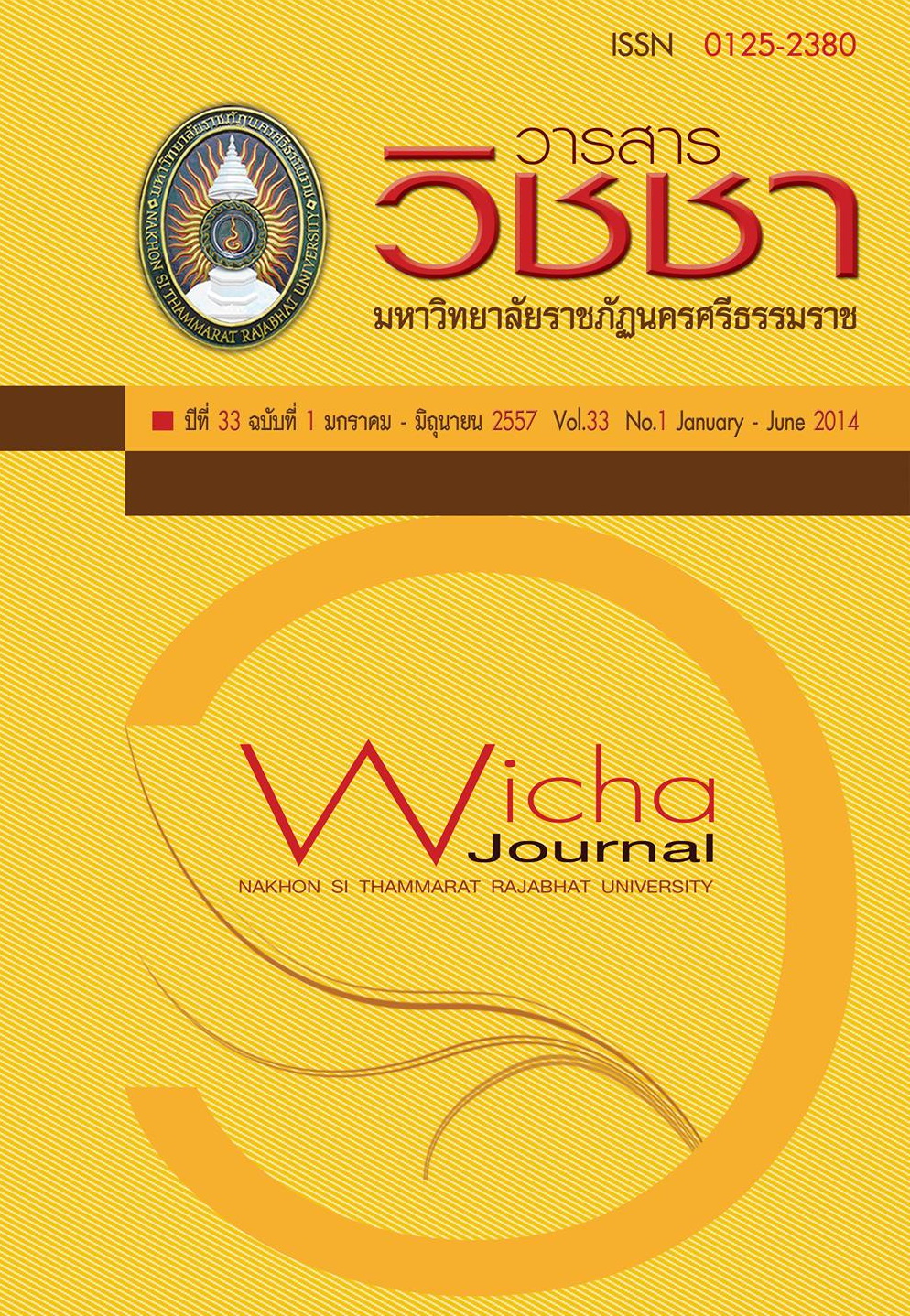ระบบพลาสมาโอโซไนเซอร์สำหรับการกำจัดจุลินทรีย์ในอาหารทะเล
Main Article Content
Abstract
บทความนี้นำเสนอวิธีการผลิตก๊าซโอโซนด้วยสนามไฟฟ้าแรงดันและความถี่สูง โดยนำหลักการของวงจร ฟลายแบคคอนเวอร์เตอร์ แบบเพิ่มระดับแรงดันไฟฟ้า โดยการออกแบบวงจรฟลายแบคคอนเวอร์เตอร์ให้ทำงานที่ความถี่ 2 กิโลเฮิร์ต ผ่านหม้อแปลงความถี่สูง วงจรเรียงกระแส และฟิลเตอร์ทางด้านเอาต์พุต เพื่อให้ได้ไฟฟ้ากระแส ตรงที่แรงดันเอาต์พุต 16 กิโลโวลต์ เพื่อนำมาประยุกต์ใช้กับหลอดโอโซไนเซอร์ที่ใช้ในงานวิจัย ประกอบด้วยหลอดโอโซไนเซอร์ยาว 0.21 เมตร ขั้วไฟฟ้าโลหะไร้สนิมและหน่วยจ่ายพลังงาน ขั้วไฟฟ้าภายในหุ้มด้วยแก้วไพเร็กซ์ซึ่ง ทำหน้าที่เป็นสารไดอิเล็กตริก ขั้วไฟฟ้าภายนอกทำด้วยโลหะไร้สนิม ช่องดิสชาร์จมีขนาด 0.0075 เมตร โดยให้ปริมาณโอโซน 20-70 มิลลิกรัม O3/ลิตรของ O2 ที่ศักย์ไฟฟ้าในช่วง 6-8 กิโลโวลต์ โดยมีอัตราการไหลของก๊าซเป็น 2 ลิตรต่อนาที พบว่าปริมาณความเข้มข้นของโอโซนเป็นปฏิภาคโดยตรงกับความต่างศักย์ไฟฟ้า อาหารทะเลที่ได้จากพื้นที่ปากนคร ได้แก่ ปลาตะกรับ(Scatophagus argus) กุ้งกุลาดำ (Penaeus monoden) ปูดำ (Scylla serrata) กั้งตั๊กแตน (Oratosquilla neap) หอยแมลงภู่ (Perna viridis) และปลากุเลา (Eleuheronema tebradactylum) นำมาหาค่าจำนวนแบคทีเรียทั้งหมด, ปริมาณโคลิฟอร์มแบคทีเรียและ E.coli พบว่าจำนวนแบคทีเรียทั้งหมดอยู่ระหว่าง 1.8×106-9.0×108CFU/g รวมถึงปริมาณโคลิฟอร์มแบคทีเรียและ E.coli อยู่ในระดับที่เกินจากมาตรฐานสินค้าเกษตร และอาหารแห่งชาติ (มกอช. 9007-2548) จำนวนแบคทีเรียทั้งหมดลดลงอย่างน้อย 1 log CFU/g ในตัวอย่างปูดำกับปลากุเลา, ลดลง 2 log CFU/g ในตัวอย่าง ปลาตะกรับกับกุ้ง และลดลง 4 log CFU/g ในตัวอย่างกังกับหอยแมลงภู่ หลังจากการผ่านโอโซนสัมผัสกับอาหารทะเล 3 นาที พบว่า จำนวนแบคทีเรียทั้งหมดลดลงอย่างน้อย 1 log CFU/g ในตัวอย่างปูดำกับปลากุเลา, ลดลง 2 log CFU/g ในตัวอย่าง ปลาตะกรับกับกุ้ง และลดลง 4 log CFU/g ในตัวอย่าง กังกับหอยแมลงภู่ โอโซนมีผลต่อการลดลงของปริมาณโคลิฟอร์มแบคทีเรียและ E.coli แต่อย่างไรก็ตามปริมาณ MPN Fecal coliform /กรัม ยังคงสูงกว่าค่ามาตรฐานที่กำหนด ทั้งนี้เนื่องจากปริมาณเชื้อเริ่มต้นที่มีอยู่สูงก่อนการผ่านโอโซน
Plasma Ozonizer System for Microbial Treatment in the Fish and Shell Fishes Sea Food
This paper presents the method of ozone gas generation using high voltage high frequency electric field, with increasing voltage flyback converter. The flyback converter is designed to operate at 2 kHz frequency through a high frequency transformer, a rectifier and filter circuits in order to operate the maximum current power supply at output voltage of 16 kV. By adapting the Plasma ozonizer consists of ozonizer cell with 0.21 m length and diameter of 35 mm, stainless steel electrode and high voltage power supply unit. An inner electrode was put in pyrex test tube which was a dielectric while discharge gap between electrode was fixed at 0.0075 m. The result showed that concentration of ozone generated was in rang of 20-70 mg of ozone/liter of oxygen feed at 6-8 kV and optimum flow rate of 2 l/min.Seafood obtained from Pak Nakhon area that is Scatophagus argus, Penaeus monoden, Scylla serrata, Oratosquilla neap, Perna viridis and Eleuheronema tebradactylum was assessed for the amount of total bacteria, coliform and E.coli. It was found that the amount of total bacteria were 1.8×106 - 9.0×108 CFU/g. The amount of coliform and detected E.coli. was higher than Thai Agricultural Commodity and Food Standard (TACFS 9007-2548). This study was conducted to determine the effects of ozonated water with different exposure times (1, 2 and 3 min). Results showed that amount of bacteria was decreased when time contact increased and ozonated water could effectively reduced 6 and 8 log of initial suspension to 4, 5, 6 and 7 log respectively of total bacteria after contacting for 3 minutes. Ozonated water could reduced all tested bacteria and inactivating E.coli. on seafoods.
Article Details
เนื้อหาและข้อมูลในบทความที่ลงตีพิมพ์ในวารสารวิชชา มหาวิทยาลัยราชภัฏนครศรีธรรมราช ถือเป็นข้อคิดเห็นและความรับผิดชอบของผู้เขียนบทความโดยตรง ซึ่งกองบรรณาธิการวารสารไม่จำเป็นต้องเห็นด้วยหรือร่วมรับผิดชอบใด ๆ
บทความ ข้อมูล เนื้อหา รูปภาพ ฯลฯ ที่ได้รับการตีพิมพ์ในวารสารวิชชา มหาวิทยาลัยราชภัฏนครศรีธรรมราช ถือเป็นลิขสิทธ์ของวารสารวิชชา มหาวิทยาลัยราชภัฏนครศรีธรรมราช หากบุคคลหรือหน่วยงานใดต้องการนำข้อมูลทั้งหมดหรือส่วนหนึ่งส่วนใดไปเผยแพร่ต่อหรือเพื่อการกระทำการใด ๆ จะต้องได้รับอนุญาตเป็นลายลักษณ์อักษรจากวารสารวิชชา มหาวิทยาลัยราชภัฏนครศรีธรรมราชก่อนเท่านั้น
The content and information in the article published in Wichcha journal Nakhon Si Thammarat Rajabhat University, It is the opinion and responsibility of the author of the article. The editorial journals do not need to agree. Or share any responsibility.


